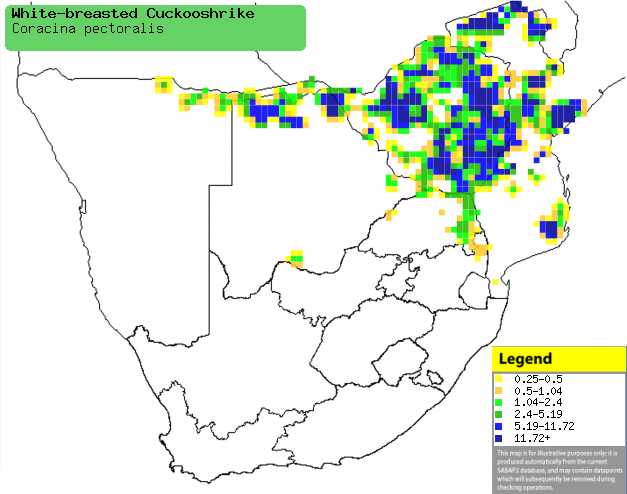|
Coracina pectoralis (White-breasted
cuckooshrike)
Witborskatakoeroe [Afrikaans]; Witborst-rupsvogel
[Dutch]; Échenilleur à ventre blanc [French]; Weißbrust-raupenfänger
[German]; Lagarteiro-cinzento-e-branco [Portuguese]
Life
> Eukaryotes >
Opisthokonta
> Metazoa (animals) >
Bilateria >
Deuterostomia > Chordata >
Craniata > Vertebrata (vertebrates) > Gnathostomata (jawed
vertebrates) > Teleostomi (teleost fish) > Osteichthyes (bony fish) > Class:
Sarcopterygii (lobe-finned
fish) > Stegocephalia (terrestrial
vertebrates) > Tetrapoda
(four-legged vertebrates) > Reptiliomorpha > Amniota >
Reptilia (reptiles) >
Romeriida > Diapsida > Archosauromorpha > Archosauria >
Dinosauria
(dinosaurs) > Saurischia > Theropoda (bipedal predatory dinosaurs) >
Coelurosauria > Maniraptora >Aves
(birds) > Order: Passeriformes
> Family: Campephagidae
Distribution and habitat
Patchily distributed across sub-Saharan Africa, occurring
along the band of Sahel savanna and Mesic woodland, from West to East Africa. It
also has a separate population south of the equator from Tanzania, Zambia and
Angola to southern Africa. Here it is uncommon, with the bulk of the population
in Zimbabwe, extending into the Caprivi Strip, northern Botswana, northern
Mozambique and the Limpopo Province, with isolated populations in the south of
Botswana and Mozambique. It generally favours well developed Mopane (Colosphermum
mopane) and Miombo (Brachystegia) woodland, occasionally occupying
riverine forest.
|
 |
|
Distribution of White-breasted cuckooshrike in
southern Africa, based on statistical smoothing of the records from
first SA Bird Atlas Project (©
Animal Demography unit, University of
Cape Town; smoothing by Birgit Erni and Francesca Little). Colours range
from dark blue (most common) through to yellow (least common).
See here for the latest distribution
from the SABAP2. |
Food
It mainly eats caterpillars, gleaning them from the trunk,
branches and leaves of trees, occasionally joining mixed-species foraging
flocks. It also takes advantage of termite alate emergences, hawking them on the
wing.
Breeding
- The nest is built solely by the female and consists of a shallow bowl made
of twigs and leaf petioles, covered in old-man's beard lichen (Usnea) and
cemented with spider web. It is usually placed on a thick branch or in
horizontal fork, often 6-20 metres above ground. Once the chicks have left
the nest it is destroyed.
- It lays 1-2 eggs, which in one observation were incubated by both sexes
for 23 days.
- The chicks are fed by both parents, leaving the nest after about 24
days, becoming independent 2-3 months later but still remaining with the
adults until the next breeding season.
Threats
Rare in southern Africa but technically not threatened,
although fragmentation of miombo (Brachystegia) woodlands in Zimbabwe may
be cause for concern.
References
-
Hockey PAR, Dean WRJ and Ryan PG 2005. Roberts
- Birds of southern Africa, VIIth ed. The Trustees of the John Voelcker
Bird Book Fund, Cape Town.
|
